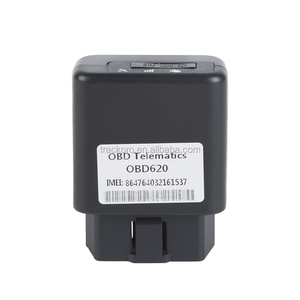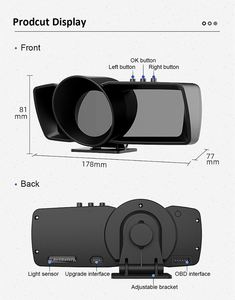(5410 products available)

































































































































































































































OBD GPS and Wi-Fi are innovative devices that combine GPS tracking and Wi-Fi connectivity to provide real-time vehicle tracking and diagnostics. These devices connect to the OBD-II port of a vehicle, allowing access to its computer system. OBD GPS and Wi-Fi come in various types, each designed to meet different needs and preferences. Here are some of them:
Standard OBD GPS Tracker
The standard OBD GPS tracker plugs into a vehicle's OBD-II port, allowing for real-time tracking and location information. This tracker uses GPS technology to provide accurate location data, enabling users to track their vehicles in real-time. The convenience of installation and the ability to access vehicle location information make the standard OBD GPS tracker a valuable tool for vehicle tracking and management.
OBD2 Bluetooth Adapter
The OBD2 Bluetooth adapter is a device that connects to a vehicle's OBD-II port and communicates with smartphones or other devices via Bluetooth. This allows access to vehicle diagnostics data, such as reading and clearing trouble codes, monitoring real-time sensor data, and accessing other diagnostic information. The OBD2 Bluetooth adapter enables users to connect wirelessly to their vehicle's diagnostic system, providing convenience and accessibility for vehicle diagnostics and monitoring.
OBD2 GPS Speed Detector
The OBD2 GPS speed detector is a device that connects to a vehicle's OBD-II port and uses GPS technology to monitor and display the vehicle's speed. By accessing the vehicle's data through the OBD-II port, the speed detector can provide accurate and real-time information about the vehicle's speed, allowing drivers to monitor their speed and adhere to speed limits.
OBD2 Scanner with GPS
The OBD2 scanner with GPS is a diagnostic tool that connects to a vehicle's OBD-II port to diagnose and communicate with the vehicle's onboard computer system. The integrated GPS functionality allows for tracking the vehicle's location, providing navigation assistance, and enabling users to monitor their vehicles remotely. This combination of diagnostic capabilities and GPS technology enhances the functionality of the OBD2 scanner, making it a valuable tool for vehicle diagnostics and monitoring.
Advanced OBD Telemetry Unit
The Advanced OBD Telemetry Unit is a sophisticated device that connects to a vehicle's OBD-II port to access its onboard diagnostics system. This unit collects and transmits various data, such as vehicle speed, engine RPM, and other real-time metrics, through GPS and mobile networks. The integration of GPS allows for accurate location tracking and navigation, while mobile network connectivity enables remote access to telemetry data. This combination of features provides comprehensive monitoring, diagnostics, and real-time telemetry information for advanced vehicle tracking and management.
The specifications of OBD GPS and WiFi are as follows:
Size and Shape
The size of the OBD GPS and WiFi is small and portable. Users can plug it into their vehicle's OBD-II port. OBD GPS and WiFi come in different shapes and designs to suit different needs. Common ones are rectangular, square, or cylindrical.
OBD-II Connector
The OBD GPS and WiFi have an OBD-II connector that allows users to connect it to the vehicle's OBD-II port. The connector must be compatible with OBD-II standards and have a secure and stable connection.
GPS Accuracy
GPS accuracy is an important feature of OBD GPS and WiFi. Users should look for ones with high accuracy and precision to do tracking and monitoring. The accuracy is measured in meters or feet and shows how close the actual position is to the one measured by the GPS.
Cellular Communication
The OBD GPS and WiFi must support cellular communication for data transfer. It should be compatible with 2G, 3G, 4G, or 5G networks for fast and stable connections. The OBD GPS and WiFi can send the data collected to a server or cloud for remote access and monitoring.
WiFi Hotspot
The OBD GPS and WiFi function as a WiFi hotspot, allowing users to connect their smartphones or other devices to the internet. The internet provided by the OBD GPS and WiFi is secure and stable, allowing for fast data transfer and communication.
Power Supply
The OBD GPS and WiFi get power from the vehicle’s OBD-II port. Thus, it is important for the device not to draw too much power. The power consumption should be low to ensure long-term operation without draining the vehicle's battery.
Data Encryption
Data encryption is an important feature of OBD GPS and WiFi. It ensures that the data transmitted over the cellular network and Wi-Fi is secure and protected from unauthorized access or interception. The encryption standards used in OBD GPS and Wi-Fi should be industry-standard and up-to-date.
Compatibility
The device should be compatible with various operating systems, such as Android, iOS, Windows, etc. This enables users to access the data collected by the OBD GPS and Wi-Fi through different applications and platforms, providing flexibility and convenience.
OBD-II Protocols
GPS and Wi-Fi OBD devices should support multiple OBD-II protocols, such as ISO 9141, KWP2000, CAN, etc. This ensures compatibility with various vehicle models and makes communication with the vehicle's onboard computer possible.
Environmental Conditions
The OBD GPS and Wi-Fi devices should be able to operate under various environmental conditions such as temperature, humidity, and vibration. This ensures stable performance and reliability in different weather and road conditions.
To maintain OBD GPS and Wi-Fi, users should follow the steps below:
Choosing the right GPS OBD device for business purposes requires careful consideration of several factors. Here are some key points to keep in mind:
Network coverage
Consider the network coverage of the GPS OBD device. Ensure that the device has coverage in the areas where it will be used. This is particularly important for businesses that operate in remote areas.
Data Plan
Some GPS OBD devices require a data plan to function. Consider the cost of the data plan and the amount of data that will be required. Ensure that the data plan is affordable for the business.
Battery Life
Consider the battery life of the GPS OBD device. Ensure that the device has a long battery life to avoid frequent charging.
Installation
Consider the installation process of the GPS OBD device. Some devices are easy to install, while others require professional installation. Choose a device that is easy to install and will not incur additional installation costs.
Data Security
Consider the data security features of the GPS OBD device. Ensure that the device has encryption and other security features to protect the business's data.
Durability
Consider the durability of the GPS OBD device. Choose a device that is rugged and can withstand harsh environments, especially for businesses that operate in tough conditions.
Customer Support
Consider the customer support options available for the GPS OBD device. Choose a device with reliable customer support to assist with any issues that may arise.
Additional Features
Consider any additional features that may be beneficial for the business. For example, some GPS OBD devices offer real-time tracking, geofencing, and diagnostic capabilities.
Most GPS trackers for cars with WiFi are easy to install. Therefore, people don't have to be vehicle maintenance experts to install them. Manufacturers provide detailed instructions on how to install the device. Below are generic steps to help business owners understand the process better.
Q1: Does my car need a GPS tracker?
A1: It depends on the user's need. However, a GPS tracker can be essential for a car for many reasons. It helps locate the vehicle in case of theft, monitors driving behavior, tracks maintenance schedules, and ensures emergency assistance. All these benefits are tracked using an OBD GPS and Wi-Fi device.
Q2: When should a GPS tracker be replaced?
A2: Users should consider replacing the GPS tracker if it can no longer receive updates, track the vehicle accurately, or communicate with the OBD port. Also, if the device shows frequent communication failure or has a degraded signal strength, it's time to replace it.
Q3: What is the warranty period for GPS tracker obd2?
A3: The warranty period for a GPS tracker OBD2 varies depending on the manufacturer and supplier. Generally, it ranges from one year to three years. During this period, users will receive free repairs or replacements for any defects or malfunctions of the device.